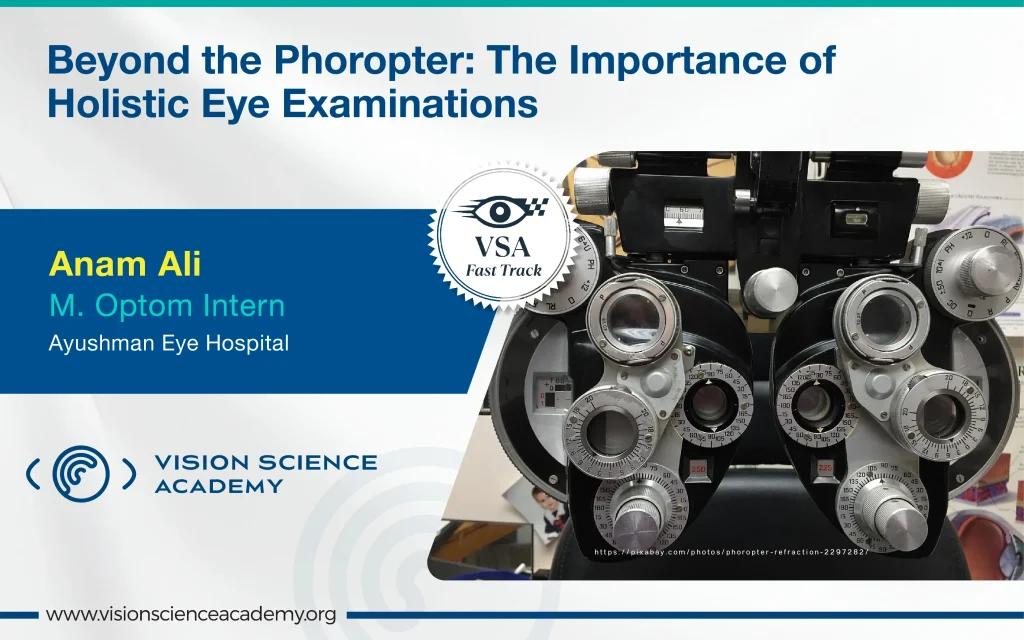Anam Ali,, B.Optom.
M. Optom Intern, Ayushman Eye Hospital, Bijnor, India
Refractive assessments remain a cornerstone of optometric practice; however, they represent only a fraction of a patient’s visual and ocular health. As primary eye care providers, optometrists play a crucial role in detecting refractive errors and identifying ocular signs of systemic and behavioural conditions. (1)
Complex patient marks today’s clinical landscape needs. Digital screen overuse, sedentary lifestyles, poor nutrition, and disrupted sleep cycles contribute to complaints like dry eye, eye strain, and transient blurring. (2,3) The rising burden of chronic diseases, such as diabetes and hypertension, further necessitates a more integrative approach, as ocular signs often precede systemic diagnosis. (4)
A model focused solely on refractive correction lacks the depth required for comprehensive care. Holistic eye examinations, addressing systemic health, lifestyle, and mental well-being, can significantly improve outcomes and foster stronger patient trust. This shift from symptom correction to person-centered care is essential in modern optometry. (5)
Core Components of Holistic Eye Examinations:
- Systemic health review:
Ocular changes may indicate systemic diseases. Conditions like diabetic retinopathy, hypertensive retinopathy, and thyroid eye disease can precede a formal medical diagnosis. The American Academy of Ophthalmology highlights optometrists’ role in early detection and referral.(4) - Lifestyle and environmental factors:
Digital eye strain affects up to 90% of screen users. (2) Poor hydration, low blink rates, improper lighting, and poor posture exacerbate symptoms. Additionally, poor diet and sleep quality impair tear film stability and ocular surface health. (3) - Medication review:
Systemic medications such as antihistamines, antidepressants, and corticosteroids can affect ocular health, causing dry eye, increased intraocular pressure, or cataracts. Gathering a comprehensive medication history is essential for effective patient care. (5) - Psychosocial considerations:
Emotional distress can manifest as visual symptoms like functional vision loss or accommodative spasms. Recognising this psychosomatic link enables better referrals and empathetic care. (6)
Clinical Relevance and Benefits:
- Early detection of systemic disorders:
Optometrists can identify early ocular signs of diabetes, hypertension, thyroid dysfunction, and autoimmune conditions. Timely detection enables prompt referral and intervention.(4) - Personalised management:
Holistic exams allow tailored recommendations based on a patient’s lifestyle, job demands, screen time, and health behaviors. Addressing root causes yields more effective care. (2) - Enhanced therapeutic outcomes:
Treatments like artificial tears may fail if underlying issues like dehydration or sleep deprivation go unaddressed. Studies show that tear film quality depends heavily on daily routines and environmental exposures. (3) - Stronger patient relationships:
Patients are more likely to trust and follow clinical recommendations when viewed as individuals rather than mere symptoms. Holistic care, characterised by empathy and active listening, fosters rapport and long-term engagement. This approach enhances compliance, patient satisfaction, and loyalty, as demonstrated in best practices for patient management in optometry. (7)
Conclusion:
In modern optometry, focusing solely on refractive issues is inadequate. The visual system is closely linked to systemic health and psychosocial factors. Holistic eye exams, grounded in medical knowledge and empathy, are crucial for quality care. Optometrists need clinical skills and the ability to explore deeper patient insights, treating the individual, not just their vision. (7)
References:
- American Optometric Association. The role of the optometrist in primary eye care. American Optometric Association; 2022. Available from: https://www.aoa.org
- Sheppard AL, Wolffsohn JS. Digital eye strain: prevalence, measurement and amelioration. BMJ Open Ophthalmol. 2018;3(1):e000146. doi: 10.1136/bmjophth-2018-000146.
- Sánchez-Brau M, Domenech-Amigot B, Brocal-Fernández F. The effect of screen exposure and lifestyle on dry eye in university students. Int J Environ Res Public Health. 2020;17(17):6309. doi: 10.3390/ijerph17176309.
- American Academy of Ophthalmology. Diabetic Retinopathy Preferred Practice Pattern. American Academy of Ophthalmology; 2021. Available from: https://www.aao.org
- Stapleton F, Alves M, Bunya VY, Jalbert I, Lekhanont K, Malet F, et al. TFOS DEWS II Epidemiology Report. Ocul Surf. 2017;15(3):334-365. doi: 10.1016/j.jtos.2017.05.003.
- Christensen JH, Glavind K, Hansen JM. Functional visual loss in children. Danish Med J. 2018;65(6):A5489.
- Zebardast N, Elam AR. Disparities in vision health and eye care. Ophthalmology. 2022;129(10):1127–1136. doi: 10.1016/j.ophtha.2022.07.001.
